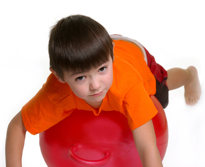Toe Walking: What it is, how to treat it
 As a Pediatric Physical Therapist I have recently encountered a surge in the incidence of children who present with Idiopathic Toe Walking (ITW). As its name implies, Idiopathic Toe Walking refers to the manifestation of this gait pattern without a known underlying pathological cause. It is extremely important to categorize this diagnosis properly. In considering differential diagnosis, we need to rule out any neuromuscular or strictly orthopedic conditions. Always assess the child’s DTRs, muscle tone and range of motion to gain the best understanding of the underlying cause of the child’s presentation. Children who present with Idiopathic Toe Walking will always be bilateral and symmetrical, as opposed to a child with spastic hemiplegia who will demonstrate unilateral involvement.
As a Pediatric Physical Therapist I have recently encountered a surge in the incidence of children who present with Idiopathic Toe Walking (ITW). As its name implies, Idiopathic Toe Walking refers to the manifestation of this gait pattern without a known underlying pathological cause. It is extremely important to categorize this diagnosis properly. In considering differential diagnosis, we need to rule out any neuromuscular or strictly orthopedic conditions. Always assess the child’s DTRs, muscle tone and range of motion to gain the best understanding of the underlying cause of the child’s presentation. Children who present with Idiopathic Toe Walking will always be bilateral and symmetrical, as opposed to a child with spastic hemiplegia who will demonstrate unilateral involvement.
A child with idiopathic toe walking may walk on his or her toes due to hyper or hyposensitivity. The child may not like the feeling of different surfaces on their bare feet causing them to rise up on their toes to decrease the surface of their foot in contact with the floor. We also need to consider the hyposensitive child. Toe walking increases the force of impact felt during ambulation, with the ground reaction force distributed through a smaller surface area at the metatarsal heads.
Weight bearing activities using a variety of textures will help provide insight, try sand, uncooked rice or beans, on an air cushion, or a tactile disk. A comprehensive history should be taken. Children who ambulate later or skip developmental milestones, which limit weight bearing are often those who present later on with ITW. Does the child toe walk when wearing shoes? Is he/she able to achieve and maintain full range of motion at the ankle? Assess the child’s overall lower extremity biomechanics, from the position of the pelvis, to the knees and feet. Assess the child’s static vs dynamic arch formation as well as plantar intrinsics. Often times, children with ITW will have weak intrinsic muscles, and use the toe walking to compensate.
Treatment Ideas:
Passive Range of Motion
1) Gastrocnemius(Ankle dorsiflexion/plantarflexion): With the child supine on back or seated, hold his/her foot in your hand apply light pressure flexing foot up towards his/her head. Once you feel resistance, hold for 20-30 seconds, alternate feet and repeat stretch.
2) Hamstring(Knee extension/flexion): With the child supine on his/her back, opposite knee bent or flat on floor, lift leg with knee straight until you feel resistance. Hold for 20-30 seconds, alternate legs and repeat stretch.
Active Range of Motion
1) Have the child stand supported/unsupported without shoes on dynamic surface (foam, air cushion, dynadisc, tilt board), as he/she shifts his/her body weight to maintain balance he/she will experience an active stretch of the affected musculature.
2) Have the child walk on dynamic surface without shoes (step down/up), similarly this will serve as an active stretch as well as a method to encourage intrinsic plantar muscle activation, as he/she will be recruiting these smaller muscles to assist with balance.
Strength
1) Intrinsic plantar muscles-negotiating uneven surfaces/dynamic support surfaces, picking objects up with toes
2) Anterior compartment musculature-seated scooter board in forward direction, stair climbing, stepping over obstacles(hurdles, cones, etc)
3) Abdominal musculature-activities which challenge core strength include seated/standing balance on dynadisc/tilt board, seated on therapy ball shifting weight posterior or laterally to activate abdominals/obliques
Sensory Integration
-Joint compressions-Vibratory input-Heavier shoes/high tops with heel cup to control calcaneus-Use of Tactile surfaces(rice and beans/textured discs)
Other ideas: baby flippers, roller skates, rain boots (all to encourage downward input)
***Also shoe choice is critical: find shoes with arch support, heel cup, fitted to foot, sturdy support/sole material
EQUIPMENT IDEAS
Email info@dinopt.com for more activity, equipment and supportive shoe suggestions!
Note: To support the site we make money on some products, product categories and services that we talk about on this website through affiliate relationships with the merchants in question. We get a small commission on sales of those products.That in no way affects our opinions of those products and services.

